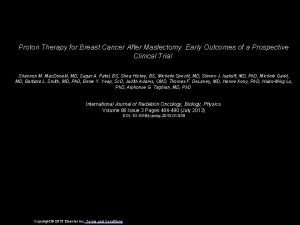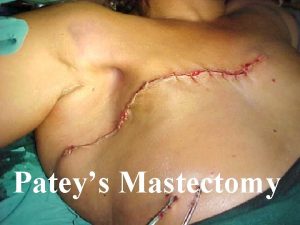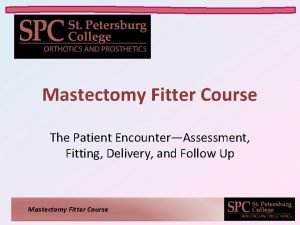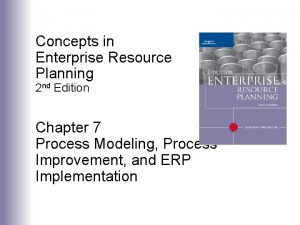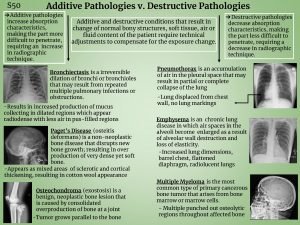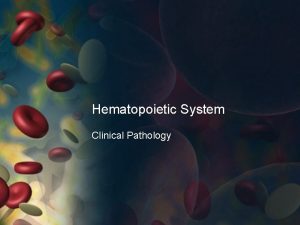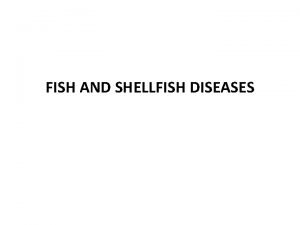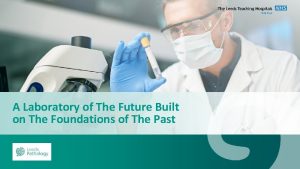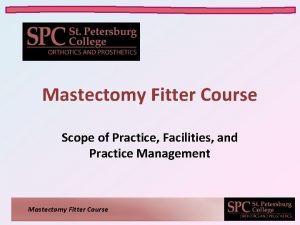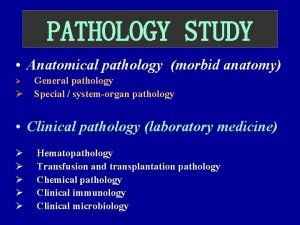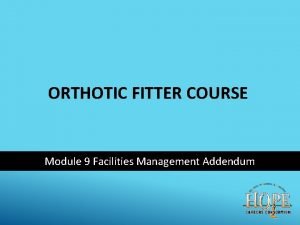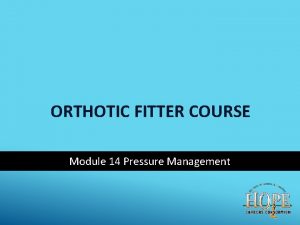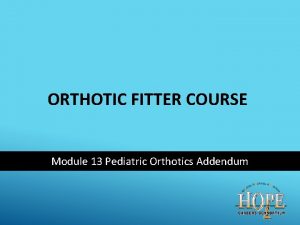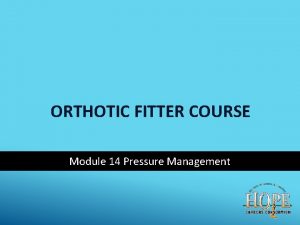Mastectomy Fitter Course Anatomy and Pathology of the





























































- Slides: 61

Mastectomy Fitter Course Anatomy and Pathology of the Post-Mastectomy Patient Mastectomy Fitter Course

Course Overview • 5 Power. Point Presentations • Multiple Choice Quizzes • One Day Face-to-Face Lab – Seven hours not including lunch – Information overview – Product familiarization – Comprehensive exam – Hands-on lab/fitting Mastectomy Fitter Course

Objectives 1. Discuss musculoskeletal anatomy including the chest, spine, and upper limb and their corresponding anatomical landmarks. 2. Describe the pathologies that accompany mastectomy patients including cancer, surgical types and lymphedema issues, and compensatory damages. 3. Define medical terminology as it relates to mastectomy. 4. Explain basic psychosocial disorders and issues that may be encountered with the mastectomy patient.

Healthy Anatomy of the Breast

Location Overview • Thorax • Pectoral Region – Superficial Compartment Mastectomy Fitter Course

Skeletal Anatomy Mastectomy Fitter Course

Skeletal Anatomy, continued • Pectoral Girdle is made up of the Clavicle and the Scapula • Upper Limb attaches to the truck at the area of the pectoral girdle and axilla or “armpit” • The pectoral girdle and proximal aspect of the humerus together make up the “shoulder” Mastectomy Fitter Course

Skeletal Anatomy Posterior Mastectomy Fitter Course

Superficial Muscular Anatomy Pectoralis Major • Largest muscle of the pectoral region • Directly under the breast • Originates from the clavicle, sternum and costal cartilages • Inserts into the axilla at the proximal end of the humerus Mastectomy Fitter Course

Deep Muscular Anatomy • Subclavius – Small muscle – Passes laterally under the clavicle • Pectoralis Minor – Originates at ribs 3, 4, and 5 and inserts into the scapula Mastectomy Fitter Course

Overview of the Breast According to Gray’s Anatomy, the breasts are composed of mammary glands and associated skin and connective tissues. Mammary glands consist of a series of ducts and their associated secretory lobules. These “lactiferous ducts” open onto the nipple for breast feeding. Interestingly, mammary glands are modified sweat glands. Mastectomy Fitter Course

Make Up of the Breast • Adipose Tissue- fat • Lobes- 12 to 20 sections – Lobules- gland that produces milk • Milk Ducts- tubes that bring milk to the nipple • Nerves- various branches of the intercostal nerves • • Suspensory Ligaments Fibrous Connective Tissue Blood Vessels Lymph Nodes and Vessels Mastectomy Fitter Course

Sagittal View 1. 2. 3. 4. 5. 6. 7. 8. Chest wall Pectoralis muscles Lobules Nipple Areola Duct Fatty tissue Skin Mastectomy Fitter Course

Anterior View Mastectomy Fitter Course

Healthy Breast Anatomy Please take a moment and watch this twominute video clip on Breast Anatomy from the National Breast Cancer Foundation. Beyond the Shock video on Breast Anatomy Mastectomy Fitter Course

Lymphatic System • The lymphatic system is composed of lymph vessels, nodes, and fluid. • It is part of the circulatory system. • Carries lymph fluid (essentially recycled plasma) back to the heart. • The circulating of lymph fluid is how cancer cells spread or metastasize. Mastectomy Fitter Course

Lymphatic System and The Breast • Approximately 75% of lymphatic drainage of the breast drains into the axillary nodes, pictured right. • Lymph drainage also passes to the supraclavicular, parasternal, abdominal lymph nodes, and the contralateral (opposite) breast. Photo courtesy of Netter’s Human Anatomy, 5 th Edition Mastectomy Fitter Course

Cancer is simply mutated cells that rapidly reproduce to make tumors. Breast cancer is cancer that develops in the breast. Mastectomy Fitter Course

Breast Cancer • One of the most common malignancies in women • Can occur in men • The Centers for Disease Control (CDC) reported 206, 966 women and 2, 039 men were diagnosed with breast cancer in 2010. 10 Mastectomy Fitter Course

Breast Cancer Statistics • ADAM Medical Encyclopedia estimates 1 in 8 women will develop a form of breast cancer in their lifetime. 12 • The National Cancer Institute estimated that 39, 620 women and 410 men died of breast cancer in 2013. 11 Mastectomy Fitter Course

Types of Breast Cancer Breast cancer is divided into categories based on where the cancer originated: – Milk Ducts- “ductal carcinoma” • Most common – Lobules- “lobular carcinoma” – Connective Tissues • Rare • Examples include phyllodes tumor and angiosarcoma • Uncommon types also include Paget’s disease and inflammatory breast cancer Mastectomy Fitter Course

Types of Breast Cancer, continued The type of cancer is then determined to be Invasive (potential to spread) or Non-Invasive (contained within the origination site). Non-Invasive Carcinomas are termed “In Situ. ” For example, Ductal Carcinoma In Situ (DCIS) and Lobular Carcinoma In Sutu (LCIS). Non-Invasive is considered Stage 0. Mastectomy Fitter Course

Stages Invasive forms of breast cancer are categorized into four stages. This is determined by examining the cancerous tissue. Chart follows: Stage Description Stage I Tumor less than 2 cm. Contained within breast, has not spread to lymph node. Stage II Either the tumor is larger than 2 cm without spreading or cancer cells are present in the axillary lymph nodes. Stage III Either the tumor is larger than 5 cm and the cancer cells have invaded the axillary lymph nodes or the tumor is smaller than 5 cm but the cancer cells are present beyond the axilla, for example in the lymph nodes above the clavicle or surrounding tissue (stroma). Stage IV Metastic Breast Cancer. Most common places of spreading are the brain, bones, liver and lungs. Mastectomy Fitter Course Link to Source of Information

Survival Rates Both treatment options and prognosis are determined by the stage the cancer is in. According to the American Cancer Society, 5 -year survival statistics are as follows in the chart: Stage. 5 -Year Survival Rate. 0 (Non Invasive) 100%. Stage II 93%. Stage III 72%. Stage IV 22%. *Due to earlier detection and enhanced treatment these rates are getting better all the time. Mastectomy Fitter Course

Known Risk Factors • Female- Men are 100 times less likely than women to get breast cancer. • Increasing age- Your risk of developing breast cancer increases as you get older. Most advanced breast cancer cases are found in women over age 50. • Family history of breast cancer- You may also have a higher risk of breast cancer if you have a close relative who has had breast, uterine, ovarian, or colon cancer. About 20 to 30% of women with breast cancer have a family history of the disease. • Genes - Mutations in the BRCA 1 and BRCA 2 genes. These genes normally produce proteins that protect you from cancer. Women with one of these defects have up to an 80% chance of getting breast cancer sometime during their life. • Menstrual cycle- Women who got their periods before age 12 or went through menopause after age 55 have an increased risk. Link to Source of Information Mastectomy Fitter Course

Other Risk Factors The following have been linked to increase risk of breast cancer, but may not be completely understood: • Alcohol use -- Drinking more than 1 to 2 glasses of alcohol a day may increase your risk. • Childbirth -- Women who have never had children or who had them only after age 30 have an increased risk. • DES -- Women who took diethylstilbestrol (DES) to prevent miscarriage may have an increased risk of breast cancer after age 40. This drug was given to the women in the 1940 s to 1960 s. • Hormone replacement therapy (HRT) -- You have a higher risk of breast cancer if you have received hormone replacement therapy with estrogen for several years or more. • Obesity -- Obese women produce more estrogen which may fuel the development of breast cancer. • Radiation -- If you received radiation therapy as a child or young adult to treat cancer of the chest area, you have a very high risk of developing breast cancer. This is especially true if the radiation was given during breast development. Mastectomy Fitter Course

Factors That Have No Correlation Breast implants, using antiperspirants, and wearing underwire bras do not raise the risk of breast cancer. There is also no evidence of a direct link between breast cancer and pesticides. 12 Mastectomy Fitter Course

Signs and Symptoms • Early forms of breast cancer are not usually symptomatic. • As the cancer develops, it may present as: – Lump in the breast or axilla – Change in the breast or nipple including size, shape, feel, or appearance • Examples include: redness, dimpling from the tightening of suspensory ligaments, orange peel like appearance to the skin – Discharge from the nipple Mastectomy Fitter Course

Signs and Symptoms, continued

Diagnosis and Early Detection Regular Mammograms (after the age of 40) and Self Breast Exams are key to early detection as early stage breast cancer is so commonly asymptomatic! Once cancer is suspected: • MRI • Ultrasound • Biopsy- needle or lumpectomy • PET Scan • CT Scan Mastectomy Fitter Course Link to Source of Information

Treatment Options Treatment options depend on the type and stage of the cancer. Treatment can be Local or Systemic. Table of treatment options: Local and Systemic. Area Treatment Options Area: Local. Involves only the area of the disease. Treatment Options: Radiation, Surgery. Area: Systemic. Affects the entire body. Treatment Options: Chemotherapy, Hormone Therapy, Biological Therapy. Mastectomy Fitter Course

Surgical Procedures • Lumpectomy – Breast-conserving surgery in which only the tumor is removed from the breast. 2 • Mastectomy – Surgery to remove all the breast tissue. 2 – Unilateral versus bilateral. Mastectomy Fitter Course

Types of Mastectomy is the removal of the whole breast. There are five different types of mastectomy: 1. “Simple" or “Total. " 2. Modified Radical. 3. Radical. 4. Partial. 5. Subcutaneous (nipple-sparing). Mastectomy Fitter Course

Simple or Total Mastectomy • Entire breast and nipple are removed. • No muscle is removed. • No axillary lymph nodes are removed. Usually appropriate for large areas of DCIS or for prophylactic measures. 4 Link to Source of Information Mastectomy Fitter Course

Example of Simple/Total Mastectomy Fitter Course

Modified Radical Mastectomy • Entire breast is removed. • Levels I and II of underarm lymph nodes are removed (B and C pictured left). • No muscles are removed. Most mastectomies today are modified radical mastectomies. 4 Mastectomy Fitter Course

Example of Modified Radical Mastectomy Fitter Course

Radical Mastectomy • Entire breast is removed. • Levels I, II, and III of the underarm lymph nodes are removed (A, B, and C pictured left). • Chest wall muscles (pectoral) are removed. Used to be standard, now is only used in extreme cases. 4 Link to Source of Information Mastectomy Fitter Course

Example of Radical Mastectomy Fitter Course

Subcutaneous “Nipple Sparing” Mastectomy • All of the breast tissue is removed, but the nipple is left alone. • Performed less often than simple or total mastectomy because more breast tissue is left behind afterwards that could later develop cancer. • Some physicians have reported that breast reconstruction after subcutaneous mastectomy can result in distortion and possibly numbness of the nipple. • Still an area of controversy among some physicians. Link to Source of Information Mastectomy Fitter Course

Example of Subcutaneous Mastectomy with Reconstruction Mastectomy Fitter Course

Mastectomy Procedures Overview For a wonderful recap of the different mastectomy procedures, take a moment and watch this two-minute video clip from the National Breast Cancer Foundation. Beyond the Shock video recap of Mastectomy Procedures Mastectomy Fitter Course

Breast-Conserving Surgeries Most often prescribed for Stages I and II • Partial Mastectomy – Removal of the cancerous part only – More tissue is removed in a partial mastectomy than in a lumpectomy • Lumpectomy Mastectomy Fitter Course

Example of Lumpectomy Mastectomy Fitter Course

Breast-Conserving Surgeries, 2 For a quick review of the different conservative procedures, take a moment and watch this two-minute video clip from the National Breast Cancer Foundation. Beyond the Shock video reviewing Breast Tissue Conservative Procedures Mastectomy Fitter Course

Breast Reconstruction Now there are more options for women undergoing the different types of surgeries including breast reconstruction and prosthetic breast forms. We will discuss prosthetic breast forms in more detail later. One last time, please take a moment to view the video on Breast Reconstruction options from the National Breast Cancer Foundation. This site is an excellent resource for you, as a mastectomy fitter, as well as your patients. Beyond the Shock video showing Breast Reconstruction Mastectomy Fitter Course

Example of Breast Reconstruction Mastectomy Fitter Course

Lymphedema is a buildup of lymph fluid in adipose “fatty” tissue just under the skin. 11 This causes mild to severe swelling. Women who have lymph nodes removed during surgery are at risk for developing lymphedema as now the lymphatic system pathways are disrupted. Radiation can also affect how the lymph system works. Mastectomy Fitter Course

Lymphedema, continued • Estimated 30% to 50% of patients who undergo axillary lymph node dissection develop some form of lymphedema. 14 • Ranges from mild to severe. • Develops slowly and usually within the first 3 years. • Usually occurs in the arms or hands. • Can occur in the chest, breast, underarm, trunk, or back. Mastectomy Fitter Course

Stages of Lymphedema Mastectomy Fitter Course

Symptoms of Lymphedema • • Swelling Heavy sensation of affected area Skin tightness and sometimes “pitting” Decreased range of motion (ROM) Mastectomy Fitter Course

Lymphedema Treatment • Lymphedema risk is decreasing due to the use of sentinel lymph node dissection, conservative surgeries, and reverse lymphatic mapping. • Medical treatment involves compression garments, physical therapy, and sequential gradient compression pumps. • The affected patient should elevate area when possible, wear loose clothing, exercise regularly, and keep skin clean and moisturized with hypoallergenic products. Mastectomy Fitter Course

Psychosocial Factors Post Mastectomy Besides the physical implications of breast cancer treatments, there are psychological and social implications as well. These include: • Body image/Self-esteem issues • Anxiety • Depression • Sexual issues Mastectomy Fitter Course

Body Image and Self-Esteem • Many describe as “disfigurement. ” • Not specific to females- both genders suffer from body image, self-esteem, and other psychosocial challenges. 17 • Striving for balance and symmetry. • Conscious of the outward attention to their surgery site, feeling of being discredited. 17 Mastectomy Fitter Course

Quote: • “Disfigurement goes beyond the superficial concern of attractiveness and touches much more profound issues regarding the presentation of self in society. The breast cancer survivor does not want to lose control of social interactions and have people’s attention diverted to their physical disfigurement as they strive for mastery over their illness. ” 17 Mastectomy Fitter Course

Anxiety/Depression • Increased risk of anxiety and depression was found in multiple studies. • As many as 72% of patients studied were affected. 16 Mastectomy Fitter Course

Sexual Disorders • As many as 35% of breast cancer survivors studied were identified as having a sexual disorder. 17 • Even when prophylactic surgery is chosen by the patient, studies show up to 50% display negative effects on body image and sexual disorders, despite their overall satisfaction with their decision. 19 • It is important to note that chemotherapy often causes premature menopause, and hot flashes and vaginal dryness along with it. Mastectomy Fitter Course

Summary Please feel free to review this Power. Point and its references as many times as you feel necessary. Please take the quiz related to this portion of the course and then continue on with the next presentation. Mastectomy Fitter Course

References 1. Netter, F. H. Atlas of Human Anatomy. 5 th Edition. Saunders/Elsevier. 2011. 2. Mayo Clinic. Mastectomy. 2011. Retrieved from website on December 17 th 2013. Link to Mayo Clinic website. 3. National Breast Cancer Foundation, Inc. Link to National Breast Cancer website. 4. Breast Cancer. org Link to Breast Cancer website. 5. Trulife. Link to Trulife website. 6. Amoena. Link to Amoena website. 7. American Breast Care. Link to American Breast Care website. 8. The American Board for Certification in Orthotics, Prosthetics & Pedorthics. Link to ABC website. 9. Medline. Plus. U. S. National Library of Medicine. Breast Cancer. Retrieved from website on December 18 th 2013. Link to Medline. Plus website. 10. Centers for Disease Control and Prevention. Breast Cancer. Retrieved from website on December 18 th 2013. Link to CDC website. 11. American Cancer Society. Link to American Cancer Society. 12. National Library of Medicine. ADAM Medical Encyclopedia. 2013. Retrieved from website on January 2 nd 2014. Link to National Library of Medicine website.

References, 2 13. Pictures of Mastectomy. Dr. Oz. Retrieved from website on January 10 th, 2014. Link to Dr. Oz website. 14. Breast Cancer Surgical Treatment Complications and Lymphedema. Women’s Health and Education Center. Retrieved from website on January 11 th, 2014. Link to Women’s Health and Education Center. 15. Prevalence and Psychosocial Factors of Anxiety and Depression in Breast Cancer Patients. 2007. Retrieved from website January 3 rd, 2014. Link to National Center for Biotechnology Information (NCBI) website. 16. Psychological and Sexual Disorders in Long-Term Breast Cancer Survivors. Retrieved from website on January 17 th, 2014. Link to Dove Press website. 17. External Breast Prostheses: Misinformation and False Beliefs. Retrieved from Website on January 17 th, 2014. Link to Medscape website. 18. Body Posture of Women After breast Cancer Treatment. 2010. Retrieved from Website on January 17 th, 2014. Link to NCBI website. 19. Body Image After Prophylactic Bilateral Mastectomy: An Integrative Literature Review. 2006. Link to NCBI website. 20. Sex After Surgery: Intimacy After Mastectomy. 2008. Retrieved from website on January 17 th 2014. Link to Health Central website. 21. Post-Mastectomy FAQs. Link to O&PCare website. 22. BOC Board of Certification/Accreditation. Link to BOC USA.

Anatomy and Pathology of the Post-Mastectomy Patient This workforce product was funded by a grant awarded by the U. S. Department of Labor’s Employment and Training Administration. The product was created by the grantee and does not necessarily reflect the official position of the U. S. Department of Labor. The U. S. Department of Labor makes no guarantees, warranties, or assurances of any kind, express or implied, with respect to such information, including any information on linked sites and including, but not limited to, accuracy of the information or its completeness, timeliness, usefulness, adequacy, continued availability, or ownership. Produced 2016. HOPE Careers Consortium is a partnership of five institutions of higher education that is building exciting new programs that will provide valuable career education and training in the Orthotics, Prosthetics, and Pedorthics (O&P) sector. The five institutions are: Baker College—Flint, Michigan; Century College—White Bear Lake, Minnesota; Oklahoma State University Institute of Technology—Okmulgee, Oklahoma; Spokane Falls Community College—Spokane, Washington; and St. Petersburg College—St. Petersburg, Florida. Although the authoring institution of this educational resource has made every effort to ensure that the information presented is correct, the institution assumes no liability to any party for any loss, damage, or disruption caused by errors or omissions. Except where otherwise noted, this work by St. Petersburg College is licensed under the Creative Commons Attribution 4. 0 International License. To view a copy of this license, click on the following link: Creative Commons Licenses 4. 0.
 Proton therapy for breast cancer after mastectomy
Proton therapy for breast cancer after mastectomy Patey mastectomy
Patey mastectomy How curable is breast cancer
How curable is breast cancer Fitter patient
Fitter patient Fitter snacker
Fitter snacker Fitter snacker
Fitter snacker Fitter snacker
Fitter snacker Fitter snacker
Fitter snacker Banff pathology course
Banff pathology course Course title and course number
Course title and course number T junction english bond
T junction english bond Course interne course externe
Course interne course externe Is osteoporosis additive or destructive
Is osteoporosis additive or destructive Introduction to cryptology
Introduction to cryptology Cryptology and pathology
Cryptology and pathology Cryptology and pathology
Cryptology and pathology Systemic pathology questions and answers pdf
Systemic pathology questions and answers pdf Introduction and importance of seed pathology
Introduction and importance of seed pathology Tronsmo plant pathology and plant diseases download
Tronsmo plant pathology and plant diseases download Tronsmo plant pathology and plant diseases download
Tronsmo plant pathology and plant diseases download Tronsmo plant pathology and plant diseases download
Tronsmo plant pathology and plant diseases download Crenation
Crenation Types of necrosis
Types of necrosis Leeds pathology tests and tubes
Leeds pathology tests and tubes Hát kết hợp bộ gõ cơ thể
Hát kết hợp bộ gõ cơ thể Lp html
Lp html Bổ thể
Bổ thể Tỉ lệ cơ thể trẻ em
Tỉ lệ cơ thể trẻ em Voi kéo gỗ như thế nào
Voi kéo gỗ như thế nào Tư thế worms-breton
Tư thế worms-breton Chúa yêu trần thế
Chúa yêu trần thế Các môn thể thao bắt đầu bằng tiếng đua
Các môn thể thao bắt đầu bằng tiếng đua Thế nào là hệ số cao nhất
Thế nào là hệ số cao nhất Các châu lục và đại dương trên thế giới
Các châu lục và đại dương trên thế giới Công của trọng lực
Công của trọng lực Trời xanh đây là của chúng ta thể thơ
Trời xanh đây là của chúng ta thể thơ Mật thư tọa độ 5x5
Mật thư tọa độ 5x5 101012 bằng
101012 bằng Phản ứng thế ankan
Phản ứng thế ankan Các châu lục và đại dương trên thế giới
Các châu lục và đại dương trên thế giới Thơ thất ngôn tứ tuyệt đường luật
Thơ thất ngôn tứ tuyệt đường luật Quá trình desamine hóa có thể tạo ra
Quá trình desamine hóa có thể tạo ra Một số thể thơ truyền thống
Một số thể thơ truyền thống Cái miệng bé xinh thế chỉ nói điều hay thôi
Cái miệng bé xinh thế chỉ nói điều hay thôi Vẽ hình chiếu vuông góc của vật thể sau
Vẽ hình chiếu vuông góc của vật thể sau Biện pháp chống mỏi cơ
Biện pháp chống mỏi cơ đặc điểm cơ thể của người tối cổ
đặc điểm cơ thể của người tối cổ V. c c
V. c c Vẽ hình chiếu đứng bằng cạnh của vật thể
Vẽ hình chiếu đứng bằng cạnh của vật thể Phối cảnh
Phối cảnh Thẻ vin
Thẻ vin đại từ thay thế
đại từ thay thế điện thế nghỉ
điện thế nghỉ Tư thế ngồi viết
Tư thế ngồi viết Diễn thế sinh thái là
Diễn thế sinh thái là Dot
Dot So nguyen to
So nguyen to Tư thế ngồi viết
Tư thế ngồi viết Lời thề hippocrates
Lời thề hippocrates Thiếu nhi thế giới liên hoan
Thiếu nhi thế giới liên hoan ưu thế lai là gì
ưu thế lai là gì Khi nào hổ mẹ dạy hổ con săn mồi
Khi nào hổ mẹ dạy hổ con săn mồi
